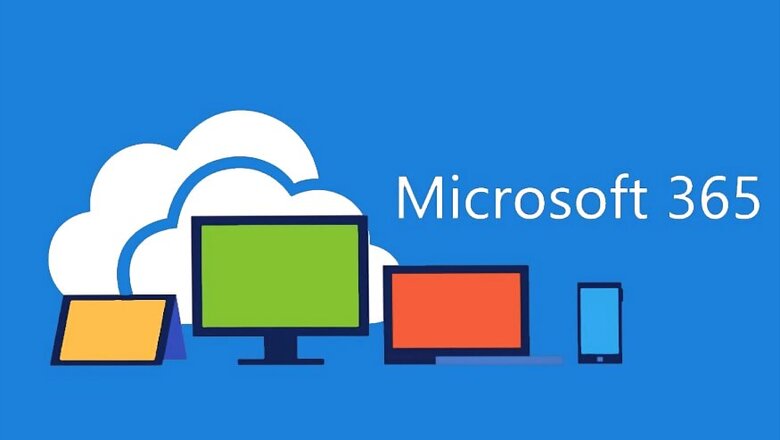
views
Microsoft is one of the world’s largest technology firms, so naturally, it invests a fair amount of time, energy and resources on artificial intelligence. Beyond the industrial applications, mainstream tools have been getting a steady entry of predictive tools into their services. Take predictive typing for instance, which is now present in everyday applications such as Microsoft’s Outlook and Google’s Gmail. That, however, only scratches the surface.
The technology, as we know it today, has far greater application in business and industries, but its consumer-end applications have been largely keyword-centric, or behind the scenes, to say the least. With its new AI tools as part of the Microsoft 365 suite, the company wants to make them visible as they operate. In other words, they want to make these tools more relevant to your everyday work. But, while their benefits are apparent, they might not be the best fit for just about anyone.
What they do
Microsoft’s AI tools have a wide range of applications. Aneesh Dhawan, director of solution sales at Microsoft India, gave a smooth demonstration of Microsoft’s AI work tools. While some range from segregating pools of data into neatly charted spreadsheets, others include ways to export a printed sheet straight to digital form without needing to type, and live captioning tools that transcribe and keep both audio-visual and textual records through video conferences. Computer vision, machine learning (ML) and natural language processing (NLP) are at the heart of these technologies, and that’s hardly surprising — if you’ve heard of AI, you’ve likely heard of all three of these as well.
In many ways, Microsoft’s AI tools for workplaces are quite good — impressive, even. For instance, if you have a video call scheduled with a new business partner that natively speaks another language, Microsoft’s new live captioning and transcription tool embedded in Teams will live caption the call right in front of you, easing communication barriers. I saw a glimpse of this during the roundtable arranged by Microsoft, and it did not seem to have any problem in picking up the average Indian English accent. Additionally, the live text transcription of conferences are crucial for someone like me, for whom manually transcribing an interview is excruciatingly painful.
Other tools include Cortana-powered automatic meeting scheduling and handsfree email writing, a visual app that can scan a sheet of paper to automatically export spreadsheets on it, and a corresponding data tool that can further segregate the data from garbled spreadsheets to generate graphs, tabulated sub-sections and more. Further NLP and visual data processing tools in Microsoft PowerPoint can transform scribbled notes into digitised forms. Essentially, from what I gathered from the brief demonstration, Microsoft’s new AI tools are robust and accurate enough to replace big data processing employees, and even EAs at work.
Who they are for
Here, however, is the catch. While everything Microsoft showed seem to work quite well, and I don’t have reason to think they won’t — Big Tech firms do make technologies that are to the point, I’m not entirely sure whether they are quite the right fit for everyone. A majority of Indian workplaces and businesses are small or medium-volume, and many offices primarily work with a limited workforce. For such companies, using a free to use service such as Google Drive, or even Microsoft’s own OneDrive, often suffice. In contrast, Microsoft’s present pricing pegs the Microsoft 365 suite at a basic price of Rs 125 per user per month, with the full productivity suite priced at Rs 1,320 per user per month.
Then comes the need for a uniform ecosystem — for all of Microsoft’s tools to work, it is important that everyone in your organisation uses a Microsoft system, and is subscribed to the Microsoft 365 suite. While this is something that a service provider should not be penalised for, it’s important to note that most workplaces that operate on a smaller scale in India mostly stick to WhatsApp or Slack for communication, and the aforementioned services for the rest. The question hence remains is whether these tools are attractive enough to warrant even those working on freeware to switch to paid services.
From the preview roundtable, Microsoft’s AI tools seem great, but tailored for larger organisations churning heavy data and hosting cross-language conferences on an everyday basis. While collaborative and digital workspaces are on the rise, Microsoft’s AI tools alone may not be the unique selling proposition to urge a business to join the company’s ecosystem.
What this means
To sum up, Microsoft may have a winner in its hands if one considers the rising need to digitise years of paperwork. Questions of privacy will be answered at a later stage, but for now, Microsoft vouches to its cybersecurity credentials. It also states that any data snippets collected from its services are done anonymously, and kept within the confines of a "select" few nations. It also states that any data collected and operated in India, stays within Microsoft's India data servers.
However, for the time being, Microsoft’s AI tools and services in the Microsoft 365 suite are better suited, by design, to large businesses. They are great at what they do, but they may not be the ones that definitively alter the definition of human effort at the average everyday workplace.




















Comments
0 comment